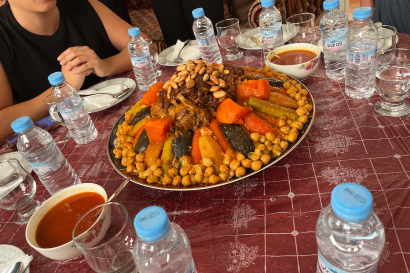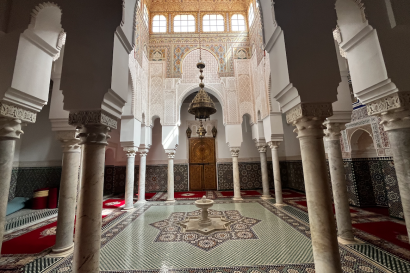As the midday sun ascended the sky in its zenith, and the train slowed down and gradually came to a stop, the barren terrain had morphed into an assortment of terracotta buildings stacked next to each other in every earthen shade. In the distance, the silhouette of the Atlas mountains peaked in the horizon. With its conical turrets and geometric designs in every earthen hue–red sandstone, golden amber, sienna, and burnt ochre—it seemed as if I had been transported to a mythical land out of the pages of A Thousand and One Nights.
Although I’ve been studying abroad in Morocco for almost six months now, I had yet to travel to Marrakech—the “Land of God”—until last weekend. Known as Al-Medinat Al-Hamra (the Red City), this ancient city has been inhabited for a thousand years and was once the imperial capital of the Berber Almoravid Empire, which stretched from the deserts of Sub-Saharan Africa in the south to the mountains of Andalusia in the north.
Although it is no longer the capital of Morocco, Marrakech is still the cultural center of the Maghreb region. Within the walls of the medieval city, there are labyrinthine alleyways where souqs (markets) sell traditional wares and crafts for travelers from all over the globe. In our short weekend-long trip, my friends and I explored every crook and cranny in the medina, admiring the gilded metal lamps, colorful scarves with intricate designs, and ornate silverware in stalls that stretched as far as the eye could see.
What Marrakech is most known for, however, is the famous Jemaa El-Fnaa Square, the beating heart of Marrakech. Here, bustling crowds watch snake charmers play traditional flute music, casting a spell on the snakes and audience alike, as well as musicians playing hypnotic Gnawa music with metal castanets. Visible from every corner of Jemaa El-Fnaa, at the center of the square stands the historic Koutoubia Mosque, which has overlooked the medina since the twelfth century. Even with the sands of time slipping through the cracks of history, Marrakech has preserved its timeless traditions. Despite its cosmopolitan transformation in the past few decades with the influx of foreigners, the daily calls to prayer begun millennia ago remain unchanged.
Given the city’s proximity to other locations, my friends and I traveled to Ouzoud falls for a day, which was just a three-hour drive away from Marrakech. An oasis of greenery in the middle of the Atlas Mountains, the Ouzoud Waterfall is the second-largest waterfall in the African continent. With the help of a local guide, we hiked along the path to the bottom of the falls, where we swam in the clear, turquoise waters and basked in the warm sunlight. As we returned, we even hand-fed wild Macaque monkeys fruits and nuts, which they responded in kind by inspecting our bags for more sweet treats and even going so far as to steal sips from our water bottles!
As I embarked on the train, the fragrant scent of orange blossoms in full bloom greeted me, leading me to discover ripe oranges delicately hanging from the trees that lined the station. I gingerly unpeeled the fruit and shared it with my friend. Though it was quite acidic, I couldn’t help but relish the bittersweet taste of fruit picked with my own hands from the source—a parting gift from the Land of God.

Dalilah Montesino
I'm from Miami and I attend Williams College, a small liberal arts college in the middle of nowhere. In my free time, I love journaling, ranting about politics with my friends, and befriending stray cats.







